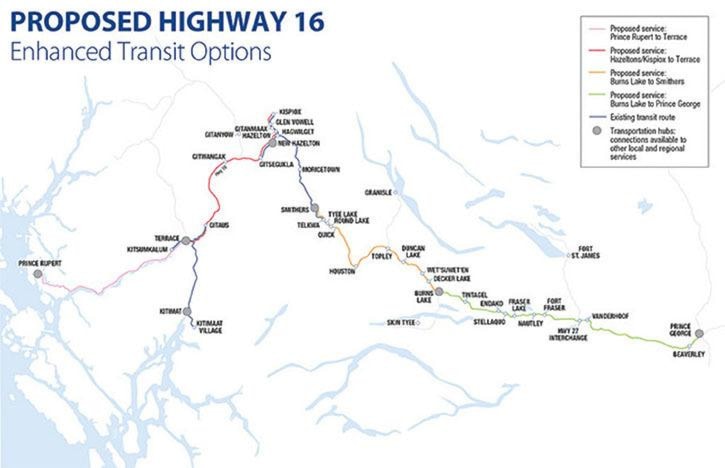The Hwy. 16 transportation action plan, a $3-million plan announced in December 2015 to enhance safety along the highway corridor from Prince Rupert to Prince George, is receiving a funding boost.
Last week, B.C. minister of transportation and infrastructure Todd Stone announced $2 million in new provincial and federal funding for the now $5-million plan.
Stone also outlined the progress made to put the plan in action.
B.C. Transit aims to have the first buses operating new or expanded service along the highway corridor by the end of 2016, and services that connect the entire corridor - from Prince George to Prince Rupert - in 2017.
“We want to see northern communities connected with safe, reliable, and accessible transportation options, in particular providing better and safer options for women and teenage girls,” said Stone.
Over the last six months, a 12-member advisory group - which includes Burns Lake Mayor Luke Strimbold - has met regularly to advance the plan, fine tune the details and develop implementation strategies.
“There are five different components to this plan; the advisory group has been working diligently on implementation plans, and today we are actively moving forward on all five steps in a significant way,” said Stone last week.
The five-point action plan includes installation of webcams and construction of transit shelters along the highway corridor; expanded or new public transit services; a community vehicle grant and operating program; a First Nations driver education program; and collaboration between existing transportation service providers along Hwy. 16.
Transit shelters will be built in communities receiving new or expanded public transit service. The new shelters will be designed for climate protection in a northern environment, good visibility, and ease of maintenance.
Once the new transit routes are confirmed, B.C. Transit staff and local communities will work together to determine optimal locations for the new transit shelters and webcams.
Last week minister Stone also announced that the application process for new community vehicles is now opened. Funding is available on a cost-shared basis to purchase and operate vehicles that will improve access to community-based transportation along the corridor. Eligible programs include those operated by or partnered with First Nations, local governments or non-profit organizations.
The First Nations driver education program will provide hands-on training to First Nations members and is intended to boost the number of qualified class four and class five drivers in First Nations communities along the Hwy. 16 corridor.
Mary Teegee, executive director of child and family services for Carrier Sekani Family Services, said it’s been 10 years since the Highway of Tears recommendation report came out and that the province is finally making progress on recommendation number one, which was to provide a shuttle service along Hwy. 16.
“I view transportation as a basic human right, and all people in the north should have access to services that are currently enjoyed by the rest of B.C.,” she said.
Burns Lake Mayor Luke Strimbold said the advisory group is striving to have every community along the Hwy. 16 corridor participating in the plan. However, Electoral Area E has opted out of the plan.
In a letter to the Regional District of Bulkley-Nechako dated March 7, 2016, Eileen Benedict, Director of Electoral Area E (Francois/Ootsa Lake Rural), requested that Electoral Area E be taken out of the financial projections for the proposed regional transit system.
“Currently, there are several unanswered questions in regard to transportation needs, public interest, impacts on existing community services, and financial implications moving forward,” says the letter signed by Benedict. “Due to the number of unanswered questions, Electoral Area E will not be providing any funding toward the project at this time.”
Minister Stone reiterated last week that the solution to the issue of safety along the highway corridor will not be a one-size-fits-all approach and that each community has its own needs.
To date, B.C. Transit and local governments along the highway corridor have signed 16 memorandums of understanding (MOU), which will allow B.C. Transit to complete more detailed service planning. B.C. Transit staff are now conducting telephone interviews with all MOU signatories.
A discussion document outlining initial options for the services will be
ready for review by these communities in early summer 2016, followed by a
more detailed service planning process which will include community engagement to determine routes, schedules and fares.
There is still much debate over the exact number of women who have gone missing along Hwy. 16 and the adjacent Hwy. 97 and Hwy. 5 since the 1970s. While the RCMP says at least 18 women went missing or were murdered, many people living in Northern B.C. believe that number could be higher.
